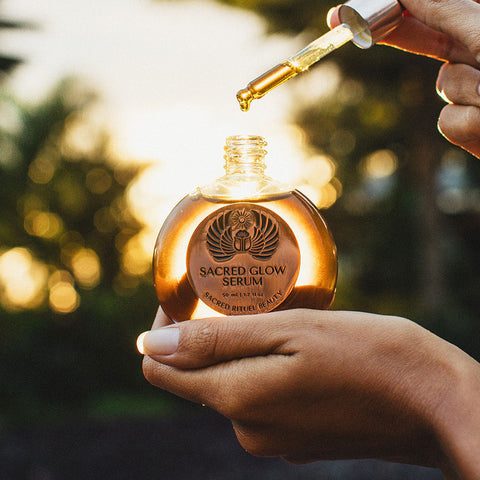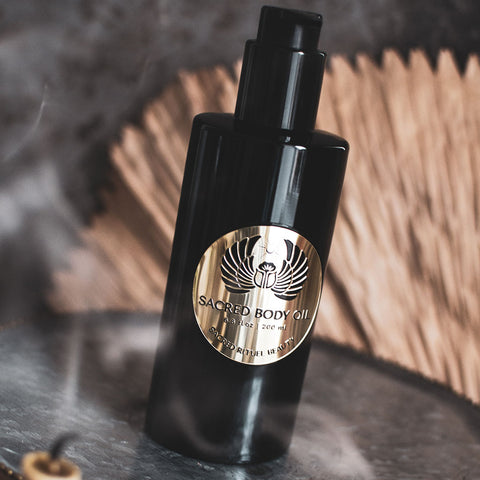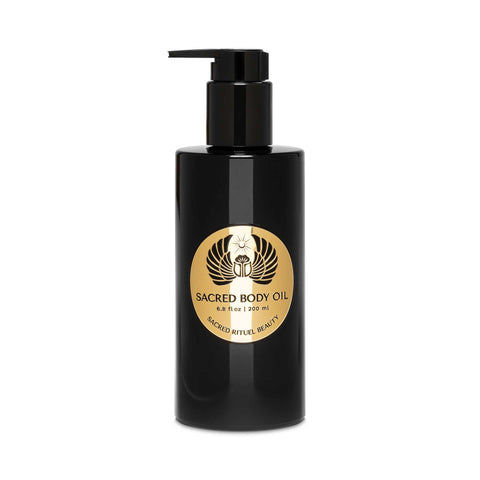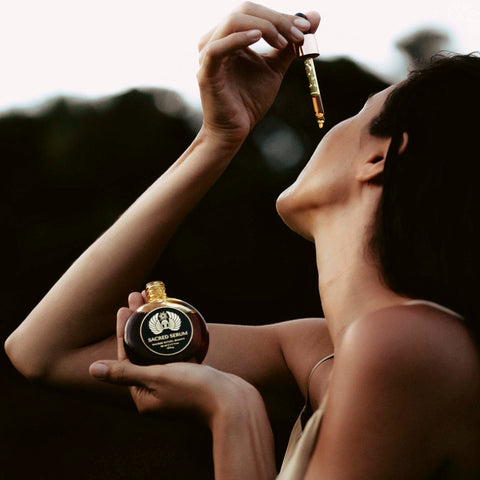
The Right Time To Use Toner In Your Skincare Routine
Key Takeaways:
- Choose the Right Toner for Your Skin Type: Selecting a toner that matches your skin type maximizes its benefits and helps avoid irritation.
- Use Toner Immediately After Cleansing: Applying toner after cleansing and before moisturizing balances your skin’s pH and enhances product absorption.
- Toners Offer Unique Benefits for Morning and Night: Morning toners refresh and prep your skin, while nighttime toners support deeper treatment and regeneration.
Toners are one of those skincare steps that can often seem a bit confusing. You might have heard that they’re great for your skin, but maybe you're wondering, “What exactly does toner do?” or “When should I actually be using it?” You're definitely not alone! Toners can be a great addition to any skincare routine, but knowing when and how to use them makes all the difference.
At Sacred Rituel, we believe that skincare should be as natural as it is effective. With years of experience in creating high-quality, organic skincare products, we’ve seen firsthand the positive impact a well-made toner can have on your skin’s health and appearance.
In this guide, we’ll discuss everything you need to know about toners, from the best time to use them to how they can benefit your skin. Let’s make toner a step that works for you, not a step that leaves you scratching your head.
What Is Toner And Why Is It Important In Skincare?
So, what exactly is toner, and why does it deserve a spot in your skincare routine? In simple terms, toner is a liquid product that you apply to your skin after cleansing but before moisturizing. Its main role is to remove any lingering dirt, oil, or impurities that your cleanser might have missed. But that’s just the start.
Toners today go beyond just cleansing; they’re often packed with skin-loving ingredients like antioxidants, vitamins, and botanical extracts that help to hydrate, calm, and even out your skin. A well-formulated toner can actually prepare your skin to absorb the products that follow, enhancing their effectiveness. Think of it as laying down the perfect base for the rest of your skincare steps.
When used correctly, toner can balance your skin’s pH, making it feel refreshed and ready for moisture. To experience these benefits firsthand, our Sacred Mist Rose Mist Toner is a perfect choice. Made with organic rose and botanical extracts, it balances, soothes, and preps your skin beautifully. Ready to give your skin a fresh, radiant feel? Try it here.
Different Types Of Toners And Their Benefits
Not all toners are created equal, and choosing the right one depends on your skin type and specific concerns. Here’s a look at some of the most common types of toners and what they bring to your skincare routine:
Hydrating Toners
Hydrating toners are crafted to provide an extra layer of moisture, particularly for those with dry or dehydrated skin. They contain ingredients thatattract water to the skin’s surface and lock it in. This helps keep skin looking plump, reduces the tightness that can follow cleansing, and prepares the skin for subsequent products.
Exfoliating Toners
Exfoliating toners are ideal for those dealing with oily or acne-prone skin, thanks to ingredients like alpha hydroxy acids (AHAs) or beta hydroxy acids (BHAs). These acids gently remove dead skin cells, clear out clogged pores, and can even help minimize the appearance of pores over time. When used consistently, exfoliating toners can smooth skin texture, even skin tone, and prevent breakouts.
pH-Balancing Toners
Designed to restore the skin’s natural pH, pH-balancing toners are excellent for sensitive or combination skin types. They work to counter the disruption caused by cleansing, especially if you’ve used a foaming or alkaline cleanser. By helping maintain the skin’s acidic mantle, these toners reduce the risk of irritation and prepare the skin for other treatments.
Soothing Or Calming Toners
Soothing toners focus on calming down redness, inflammation, and irritation, which is especially beneficial for sensitive or reactive skin. They include anti-inflammatory ingredients like rose water, which help reduce visible signs of stress on the skin. With regular use, soothing toners support the skin barrier, creating a more resilient and balanced complexion.

Astringent Toners
Astringent toners contain ingredients like witch hazel or alcohol to help control excess oil production, making them popular for very oily skin types. They work by temporarily tightening the skin and reducing shine, giving a matte effect. However, astringents can be drying if overused, so they’re best used sparingly or in specific areas prone to oiliness.
When Should You Use Toner In Your Skincare Routine?
The ideal time to use toner is right after cleansing, while your skin is still slightly damp. Cleansing can disrupt your skin’s natural oils and pH, and a toner can help restore balance while also prepping your skin for the next steps. Applying toner immediately after cleansing allows it to penetrate more effectively and lay the groundwork for serums, moisturizers, or any treatments you plan to use.
To recap, the steps are:
- Cleanse – Removes dirt, oil, and impurities.
- Toner – Restores balance and preps the skin.
- Serums, Moisturizer, and SPF – Absorb better on toned skin.
Following this order optimizes each product’s effectiveness and helps create a routine that leaves your skin refreshed, balanced, and ready for nourishment.
Morning Vs. Night: Best Times For Using Toner
Using toner both in the morning and at night can offer unique benefits, depending on your skin’s needs and the type of toner you’re using. Let’s break down the advantages of using toner at each time of day:
Morning
In the morning, toner can serve as a refreshing base to start your day. It helps remove any oils or impurities that may have built up overnight and prepares your skin for daytime products, like moisturizers and sunscreen. If you’re using a hydrating or pH-balancing toner, applying it in the morning can give your skin a healthy, radiant look throughout the day.
Night
Nighttime is an ideal time for deeper skincare treatments, so using toner in the evening helps cleanse the skin thoroughly after makeup, sunscreen, and environmental exposure. For those using exfoliating or treatment-focused toners, evening application is especially effective, as your skin regenerates overnight. This gives the active ingredients time to work without interference from sun exposure, reducing sensitivity.
How To Apply Toner For Maximum Benefit
Applying toner might seem straightforward, but using the right technique can enhance its effectiveness and ensure you get the most out of your product. Here’s a step-by-step guide for optimal application:
Choose Your Method
Toner can be applied in several ways, depending on personal preference and the toner’s formulation. One option is to use a cotton pad to gently swipe toner across your face, which helps remove any remaining impurities while evenly applying the product. Another option is to pour a few drops into your palms and pat it directly onto your skin, which works well for hydrating toners and minimizes product waste.
Apply To Clean Skin
Always use toner on freshly cleansed skin, as this allows the toner to penetrate effectively. Cleansing opens up your pores, making it easier for the toner to restore balance and deliver nutrients to the skin. Applying it to clean skin also preps it for absorbing serums and moisturizers more effectively, maximizing your routine’s impact.
Avoid Sensitive Areas
While applying toner, it’s best to avoid the eye area unless your toner is specifically formulated for this delicate zone. The skin around the eyes is thinner and more prone to irritation, which can lead to dryness or sensitivity. Instead, focus application on the T-zone, cheeks, and chin, where toners are most effective.
Let It Absorb
Give the toner a few seconds to fully absorb before moving on to serums or moisturizers, which helps the product work its magic without interference. This short pause allows the toner to lock in its benefits, ensuring your skin is balanced and ready for the next steps. Plus, by allowing each layer to settle, you create a smoother canvas for better layering and product absorption.
Layer Serums And Oils After Toner
After toner has absorbed, apply your serums or treatments. If you use a face oil, it should be applied toward the end of your routine, typically after your moisturizer. Face oils provide a nourishing, protective layer that locks in hydration, making them an excellent option, especially at night or for dry skin types.
Common Mistakes To Avoid When Using Toner
While toner can be a powerful addition to your skincare routine, some common mistakes can prevent it from working effectively. Here are a few things to watch out for:
Using Too Much Toner
Applying too much toner can overwhelm your skin, especially if it has active ingredients like acids or alcohol. This can lead to irritation, dryness, or even disrupt the skin's natural barrier. A small amount, like a few drops, is usually sufficient to cover your entire face without causing overload.
Skipping Toner In The Routine
Many people skip toner, viewing it as an optional step, but it plays a vital role in balancing the skin after cleansing. Without toner, your skin may not fully absorb the benefits of serums and moisturizers that follow. Including toner helps prime the skin, enhancing the overall effectiveness of your skincare products.
Applying Toner Directly On Broken Or Irritated Skin
If your skin is already inflamed or has active breakouts, certain toners—especially those with alcohol or acids—can worsen sensitivity. This can lead to stinging, redness, or further irritation, making the skin take longer to heal. In such cases, it's best to stick to a gentle, soothing toner or avoid using it until your skin recovers.
Not Considering Skin Type When Choosing Toner
Using a toner that doesn’t match your skin type can do more harm than good. For example, alcohol-based toners may excessively dry out sensitive or dry skin, while oily skin types may need something more balancing. Choosing the right toner for your specific needs ensures you’re reaping its benefits without negative side effects.
Skipping Sunscreen When Using Exfoliating Toners
Exfoliating toners can make your skin more sensitive to sunlight, which increases the risk of sunburn or hyperpigmentation. Using sunscreen daily is crucial to protect your skin, especially if you’re using products with acids or retinoids. Without sun protection, you may undo the benefits of your skincare routine and leave your skin vulnerable to damage.

Final Thoughts
Incorporating toner into your skincare routine can significantly improve the health and appearance of your skin. While it may seem like a small step, the right toner can balance, hydrate, and prepare your skin, enhancing the benefits of your other skincare products. By choosing a toner that suits your skin type, applying it correctly, and using it consistently, you can elevate your skincare routine and enjoy smoother, more radiant skin.
Remember, skincare is all about finding what works best for you. Don’t be afraid to experiment and adjust your routine as your skin’s needs change. Whether you’re new to toners or looking to make the most of this step, embracing toner can be a simple yet effective way to give your skin the care it deserves.
Read also:
- Understanding The Benefits Of Toner For Your Skin
- How Facial Oil Helps Manage Acne-Prone Skin
- How Body Oil Super Hydrates And Treats Dry Skin Conditions
Frequently Asked Questions About Using Toner In Your Skincare Routine
Can I use toner without a moisturizer?
While toner helps balance and hydrate, it’s not a substitute for moisturizer. Toner preps the skin, but a moisturizer locks in hydration.
Is it okay to use toner every day?
Yes, most toners can be used daily. However, exfoliating toners with acids should be limited to a few times a week to avoid over-exfoliation.
Should I wash my face after applying toner?
No, toner is meant to stay on the skin. Applying it after cleansing and before moisturizing ensures it delivers its full benefits.
Do I need to use a toner if I double cleanse?
Yes, even after double cleansing, toner can balance the skin’s pH, soothe, and prep it for better absorption of subsequent products.
How long should I wait after toner to apply other products?
Wait a few seconds until the toner fully absorbs. Skin should feel damp but not wet before moving on to serums or moisturizers.
Can I use toner on sensitive skin?
Yes, sensitive skin types can use toner, but it’s best to choose alcohol-free, soothing toners with ingredients like chamomile or rose water.
Should toner be applied with hands or a cotton pad?
Both methods work, but applying with hands can reduce product waste and is gentler on the skin, while a cotton pad removes residual impurities.
What’s the difference between toner and micellar water?
Micellar water is a cleansing product, while toner is a treatment product that balances and preps the skin post-cleansing.
Can toner be used around the eyes?
It’s generally recommended to avoid the eye area unless the toner is specifically formulated for sensitive areas.
Sources:
- Purnamawati, S., Indrastuti, N., Danarti, R., & Saefudin, T. (2017). The Role of Moisturizers in Addressing Various Kinds of Dermatitis: A Review. Clinical Medicine & Research, 15(3-4), 75–87. https://doi.org/10.3121/cmr.2017.1363
- Lee, J. S., Ha, J., Shin, K., Kim, H., & Cho, S. (2019). Different Cosmetic Habits Can Affect the Biophysical Profile of Facial Skin: A Study of Korean and Chinese Women. Annals of Dermatology, 31(2), 175–185. https://doi.org/10.5021/ad.2019.31.2.175
- Mim, M. F., Sikder, M. H., Chowdhury, Md. Z. H., Bhuiyan, A.-U.-A., Zinan, N., & Islam, S. M. N. (2024). The dynamic relationship between skin microbiomes and personal care products: A comprehensive review. Heliyon, 10(14), e34549. https://doi.org/10.1016/j.heliyon.2024.e34549







Commentaires (0)
Il n'y a pas de commentaires pour cet article. Soyez le premier à laisser un message !